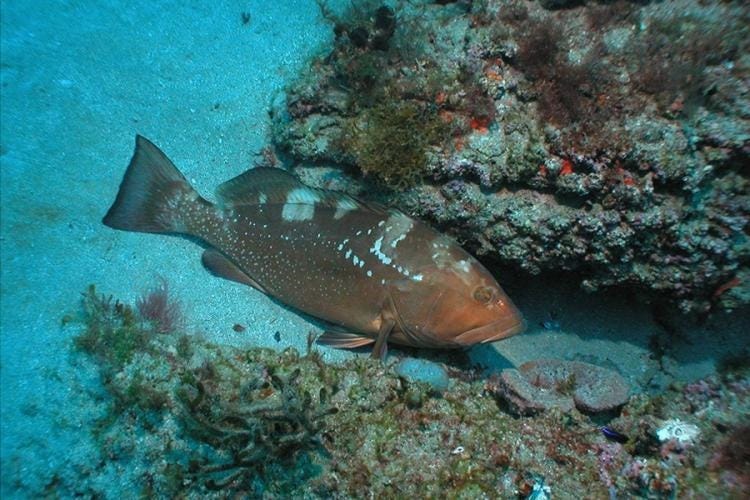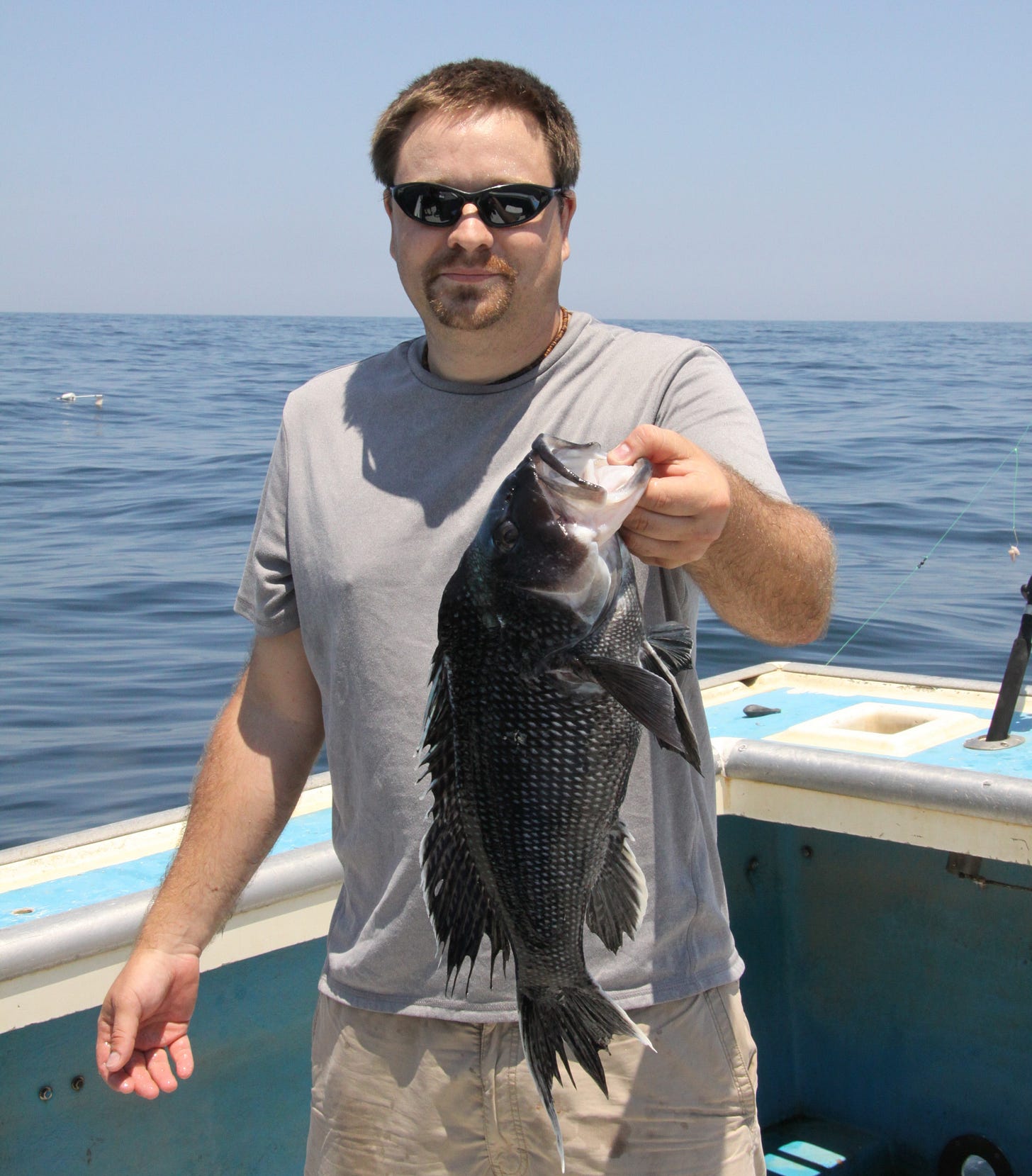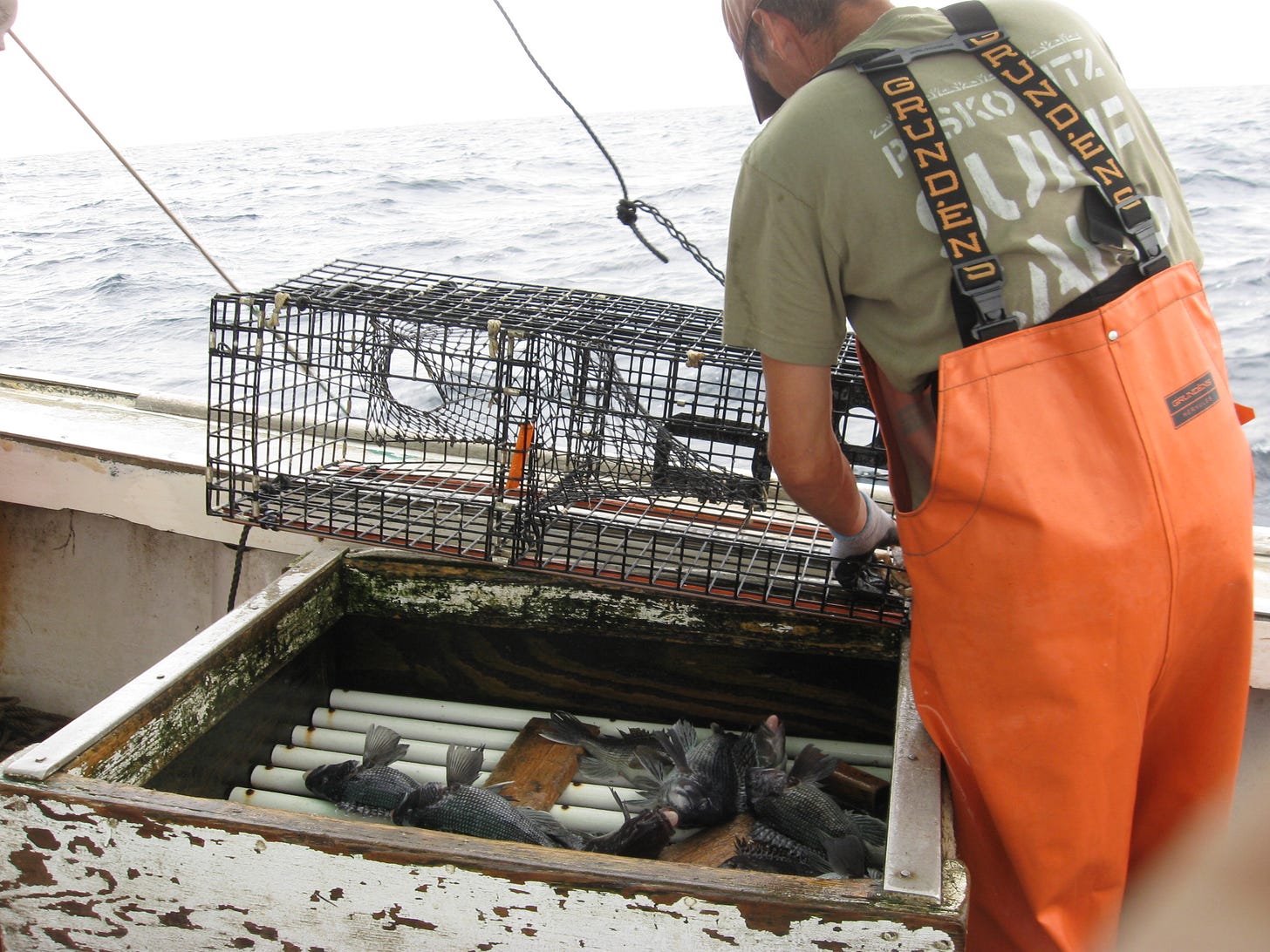Groupers Don't Get No Respect (Sustainable Seafood #15)
Some of the tastiest fish in the ocean are rarely identified by name (except Black Sea Bass)
On my first trip to Puerto Rico, we dined at an outdoor restaurant overlooking a bay. Our meal consisted of a whole grilled grouper, which was delicious. When we finished, nothing was left but the head, backbone and part of the tail (we ate the crispy parts). At the end of the meal, our waiter asked me if I wanted to feed the scraps to the fish that were swarming around the edge of the dining area.
“Oh, no,” I exclaimed indignantly, giving rise to my inner eco-scold, “giving human food to wildlife is a terrible idea”.
“Well, everyone else is doing it,” he said.
Not wanting to be a party pooper, I agreed. “OK, ok, we’ll do it,” I said.
I then carried the plate to the edge of the deck and looked down into the water. Milling around below the dining deck, there were at least a dozen large tarpon waiting to be fed. With a fork, I pushed the fish carcass off the plate. As soon as it hit the water, a big fish jumped up and wolfed down the entire grouper head, while the others splashed around it in a feeding frenzy, trying to grab whatever was left. This activity seemed to delight the other patrons, who were also doing the same thing with their leftovers. When in Rome, I guess.
Many species, but rarely identified
Grouper is one of the most common and one of the best fish to eat throughout the Caribbean and tropics. They include a large number of species, ranging from too small to eat, to the giant Goliath grouper that reaches over 5 feet in length. The majority of them (60%) on the market are Red Grouper Epinephelus morio; Gag Grouper Mycteroperca microlepis make up another 20%. The rest include Yellowedge Grouper, Black Grouper, Snowy Grouper, and others. Because so many different types are caught, they are rarely identified by species names in seafood markets or restaurants. In that respect, Groupers “don’t get no respect” (to quote Rodney Dangerfield).
Where: Grouper are present from Massachusetts to the Gulf of Mexico, and throughout the South Atlantic Ocean. They live around reefs and ledges to about 60 feet of depth.
FAQs: Groupers have a blunt head with a large mouth. Some can reach 50 inches in length, and 50 pounds weight, and live up to 30 years. Black grouper can reach 5 feet in length and 180 lbs. Groupers are highly carnivorous ambush predators, eating other fish, lobster, octopus, shrimp, crabs, and squid. They are prey of jacks, larger grouper, and sharks. Most groupers are protogynous – they mature first (proto-) as females (gynous), at the age of 4-5 years old. Many then transform to males at ages of 7-10 years. Nassau groupers live mostly in the Caribbean, and form large spawning aggregations comprised of thousands of individuals during the full moon in winter. Their populations have been overfished in most regions and they are now considered commercially extinct.
Fishery: Most groupers are caught using hook-and-line gear, which could include longlines or handlines. Trawls and traps are prohibited. Grouper are highly popular among recreational fishermen, with over 6.6 million lbs of all species landed in 2022, whereas commercial landings were 4.85 million lbs. Commercial fisheries for Groupers in US waters are managed by the Gulf of Mexico, South Atlantic, or Caribbean Fishery Management Councils.
Sustainability: When brought up from deep water, groupers may suffer from barotrauma (see Sustainable Seafood 11. Bycatch and Discard Mortality). Rapid expansion of the gas bladder causes the stomach to evert through the mouth, and causes the eyes to bulge out (exopthalmia). This can quickly kill the fish by suffocation, and affected fish cannot submerge themselves. Fish that are below legal size must be released but may suffer very high mortality. Methods to prevent mortality have been developed, which include venting the gas bladder by inserting a hypodermic needle. Sports fishers often use a descender, which is clamped onto the lip of the fish, then dropped back down into the water; as it sinks rapidly, the gas bladder is recompressed, and when it hits bottom, a trigger releases the fish.
Status: Red Grouper populations in the Gulf of Mexico are healthy. The South Atlantic Stock (of the US, meaning Florida to North Carolina) was overfished following a large recruitment pulse in 2004-2008, but is now considered stable. Gag Grouper are overfished in both the Gulf of Mexico and the South Atlantic region. Grouper are present throughout the Caribbean as well, but stocks are not surveyed, so their status is unknown.

Nutrition: When cooked, Grouper filets are white, firm, moist, and flaky. They are high in protein, extremely low in saturated fat and cholesterol, and a good source of omega-3 fatty acids as well as vitamins B6 and B12, phosphorus, potassium, protein, and selenium.
Stevens Palatability Index (SPI): 4.0 I love a whole grilled fresh grouper.
Black Sea Bass – Another Non-Bass
Location: The Black Sea Bass Centropristis striata is a type of grouper that is common from Maine to Florida and the Gulf of Mexico. It lives around rocky reefs, jetties, wrecks, and hard-bottom structures. Adults live offshore in 60 to 130 feet (18 to 40 meters) of water. In the winter, they migrate offshore to deeper water. Juveniles recruit to coastal estuaries for their first two years, then move out to offshore reefs.
FAQs: Black Sea Bass can reach 2 to 10 lbs, and up to 24 inches in length. Like most groupers, they are protogynous hermaphrodites, maturing first as females at age 4, then transitioning to larger males at the age of 6 or 7 years. Males aggressively defend groups of females called “harems”. In the Mid-Atlantic region, black sea bass live predominantly around reefs and wrecks with vertical structure, especially sea whip corals.
Fishery: Black Sea Bass are caught using wire traps very similar in size and construction to lobster traps. The same traps may be used for lobster fishing later in the season. Black Sea Bass are highly valued recreational fish, and head boats routinely take out dozens of fisher-passengers from ports from Massachusetts to North Carolina. They may also be captured as bycatch in trawl fisheries, and by spearfishing. The Black Sea Bass fishery is managed by the Atlantic States Marine Fisheries Commission. In 2022, the US commercial catch was 5 million lbs, and the recreational catch was 9 million lbs.
Sustainability: High. The population is healthy and well-managed.
Sea Food Watch considers Black Sea Bass to be a "Best Choice", if trawl caught. They suggest avoiding fish caught by traps, which includes most of the catch. They claim that trap buoy lines may entangle whales. I disagree with that recommendation, however. As far as we know, whales are primarily entangled by lobster or crab trap lines. Fishing for Black Sea Bass is mostly conducted using long strings of traps, with up to 20 traps attached to a groundline, and one buoy on each end of the line, for a buoy to trap ratio of 1:10 1. This is exactly what conservationists are trying to encourage lobster fishers to do, instead of using one buoy line for each trap.
Fishing Impacts: When fishing for Black Sea Bass, trap fishermen discard small fish that are below the legal size limit. A study in 2014 indicated that discard mortality was 13%, but the traps were only fished for 1-2 days. My students and I conducted studies using trap sets of 10-12 days which are more typical of the actual fishery 2, and estimated discard mortality to be 40-50% 3. By placing cameras on traps, we learned that the traps get dragged across the seafloor when they are being retrieved, which disturbs and damages corals and other habitat elements that the fish depend on for shelter 4.
Product: Black Sea Bass are sold as whole fish or fillets. They can be baked, grilled, fried, or poached. They have a mild, sweet flavor and firm, flaky texture.
Health and Nutrition: Black Sea Bass are a lean source of protein and are low in fat and calories. They are rich in omega-3 fatty acids, vitamin B12, selenium, and phosphorus.
SPI: 4.0 Despite the potential habitat impacts of trawl and trap fishing, I give Black Sea Bass a rating of 4.
Conclusion
Whether you are in the tropics or the southeast United States, grouper are great fish to eat. They can be baked, grilled, blackened, or roasted whole. However you eat them, they are one of the healthiest and tastiest fish available. In the Northeast and Mid-Atlantic, look for Black Sea Bass. Better yet, book a trip on a party fishing boat and go catch your own!
Writing about nature is not easy. It requires preparation, hard work, and sometimes sweat to observe nature, and time, thought, and effort to describe it. Not to mention catching all those black sea bass! Although this post is free, becoming a paid subscriber will help me continue to share my thoughts, and encourage future postings.
This issue of Ecologist at Large is available to all readers. However, if you would like to support my work with a one-off contribution, click “Buy me a coffee” below.
Sources:
Schweitzer, C. C., R. N. Lipcius, and B. G. Stevens. 2018. Impacts of a multi-trap line on benthic habitat containing emergent epifauna within the Mid-Atlantic Bight. ICES Journal of Marine Science 75(6):2202-2212. https://doi.org/10.1093/icesjms/fsy109
Cullen, D. and B. G. Stevens. 2017. Video Examination of Black Sea Bass Trap Catches in Relation to Soak Time in the Mid-Atlantic Bight. N. Amer. J. Fish. Manag. 37: 9-15. https://doi.org/10.1080/02755947.2016.1235630 .
Schweitzer, C. C., A. Z. Horodysky, A. L. Price, and B. G. Stevens. 2020. Impairment indicators for predicting delayed mortality in black sea bass (Centropristis striata) discards within the commercial trap fishery. Conservation Physiology, 8(1), coaa068, https://doi.org/10.1093/conphys/coaa068
Schweitzer, C. C., and B. G. Stevens. 2019. The relationship between fish abundance and benthic community structure on artificial reefs in the Mid-Atlantic Bight, and the importance of sea whip corals Leptogorgia virgulata. PeerJ 7:e7277. https://doi.org/10.7717/peerj.7277









